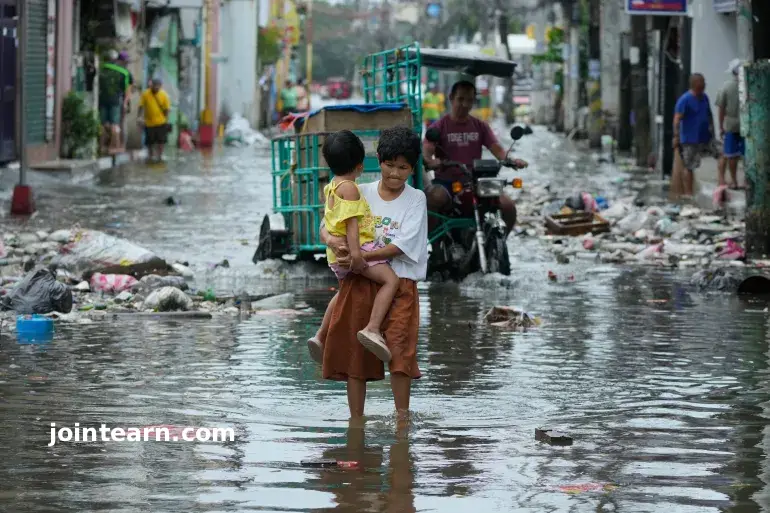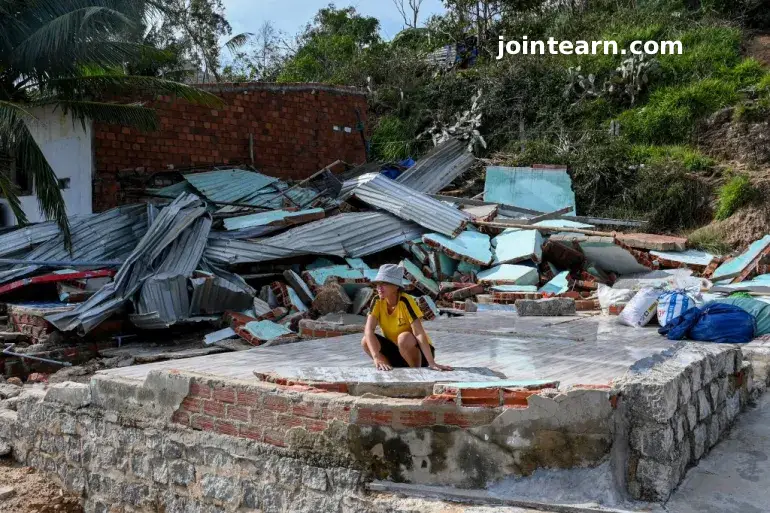
Massive Storm Leaves a Trail of Destruction Across the Philippines
Manila, Philippines — The Philippines is reeling from the devastation left by Super Typhoon Fung-wong, which battered northern regions with torrential rains, fierce winds, and deadly landslides. At least 10 people have been confirmed dead, while 1.4 million residents were forced to flee their homes as floodwaters engulfed entire communities.
Known locally as Typhoon Uwan, the powerful tropical cyclone struck the country just one week after Typhoon Kalmaegi, which left 232 dead across central provinces. The back-to-back disasters have intensified calls for climate justice and stronger disaster resilience measures in one of the world’s most typhoon-prone nations.
Fung-wong made landfall in Aurora Province on Sunday night, unleashing sustained winds of 185 km/h (115 mph) and gusts of 230 km/h (143 mph) before weakening over the mountainous northern Luzon region.
Northern Provinces Hit Hard as Floodwaters Rise
Authorities said at least 132 villages in northern Luzon were inundated by floodwaters, leaving hundreds trapped on rooftops in cities such as Ilagan and Tuguegarao.
“While the typhoon has passed, its rains still pose a danger in certain areas,” warned Bernardo Rafaelito Alejandro IV, spokesperson for the Office of Civil Defense (OCD).
“We are continuing rescue and relief operations, particularly in flood-prone communities.”
The provinces of Catanduanes, Eastern Samar, Nueva Vizcaya, Mountain Province, and Ifugao reported multiple casualties from flash floods, electrocution, and landslides.
Three children were among those killed in separate landslides in Nueva Vizcaya, while another deadly slide in Kalinga Province left two villagers dead and two missing.
So far, the OCD has recorded over 4,100 damaged homes, with widespread power outages and blocked roads hampering relief efforts.
1.4 Million Evacuated as Government Declares State of Emergency
In total, more than 1.4 million people sought refuge in evacuation centers or the homes of relatives, according to the National Disaster Risk Reduction and Management Council (NDRRMC). As of Tuesday, about 240,000 evacuees remained in temporary shelters across northern Luzon.
President Ferdinand Marcos Jr. declared a state of emergency following the storm, just days after issuing the same order in response to Typhoon Kalmaegi’s catastrophic impact.
The government has mobilized military units, coast guard teams, and local emergency workers to deliver relief goods, restore communication lines, and assess damage to infrastructure and agriculture.
Typhoon Fung-wong Follows Deadly Path of Kalmaegi
Fung-wong’s arrival compounded the humanitarian crisis left by Typhoon Kalmaegi, which struck the central Philippines on November 4, killing 232 people and displacing hundreds of thousands before crossing into Vietnam.
Experts warn that the back-to-back typhoons highlight the Philippines’ worsening exposure to climate-induced weather extremes, driven by warming oceans and shifting atmospheric patterns.
“What we are witnessing is not coincidence—it’s climate escalation,” said Dr. Maria Lorenzo, a climate scientist at the University of the Philippines.
“The Philippines sits in the world’s most active typhoon belt, and warming seas are making storms more intense and destructive.”
Climate Change and the Growing Cost of Disasters
According to the United Nations Office for Disaster Risk Reduction (UNDRR), the Philippines ranks among the top three countries most vulnerable to tropical storms, earthquakes, and floods.
The frequency and intensity of Category 4 and 5 storms have risen dramatically over the past decade. Scientists attribute this to climate change, as warmer oceans release more energy and moisture into tropical systems.
The twin disasters come as world leaders gather in Belem, Brazil, for the COP30 United Nations Climate Change Conference, where developing nations like the Philippines are demanding greater financial support from industrialized countries to cope with the rising costs of climate-related catastrophes.
“We emit the least but suffer the most,” said Philippine Climate Envoy Leila Santos in a statement.
“It’s time for the world’s biggest polluters to honor their commitments and fund climate adaptation for vulnerable nations.”
Resilience Tested as Relief Efforts Continue
Rescue teams continue to struggle through landslide-blocked roads and flooded fields to deliver aid to remote communities. In Isabela Province, residents were seen waving from rooftops, waiting to be rescued from submerged homes.
The Philippine Red Cross, UNICEF, and local NGOs have mobilized emergency teams to provide food, medical supplies, clean water, and temporary shelter.
“The scale of displacement is staggering,” said Richard Gordon, chairman of the Philippine Red Cross.
“Entire communities have lost everything. Recovery will take months, if not years.”
Meteorologists say Fung-wong has weakened as it moves northwest toward Taiwan, though heavy rains continue to threaten northern Luzon and Metro Manila with flash floods and landslides.
The Global Climate Connection
The Philippines’ twin typhoons have renewed international debate on climate justice and loss-and-damage funding for countries that contribute minimally to global carbon emissions.
Experts say the two storms exemplify the urgent need for climate adaptation, including better early-warning systems, climate-resilient infrastructure, and sustainable housing for coastal populations.
As the COP30 summit convenes, the Philippines stands as a stark reminder of how the climate crisis disproportionately harms nations least responsible for it.
Key Takeaways
- At least 10 dead, 1.4 million displaced after Typhoon Fung-wong hits the Philippines.
- The storm struck just a week after Typhoon Kalmaegi killed 232 people.
- Government declares a state of emergency and deploys nationwide rescue operations.
- Climate change is making tropical storms more frequent and severe.
- COP30 in Brazil renews calls for global climate funding and accountability.

Leave a Reply